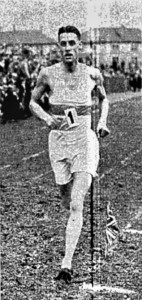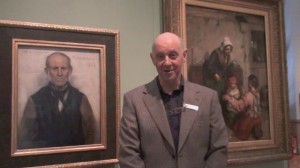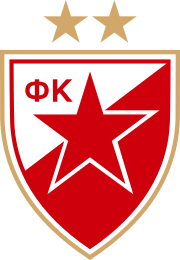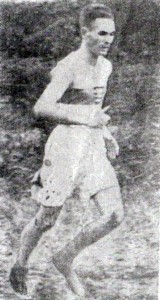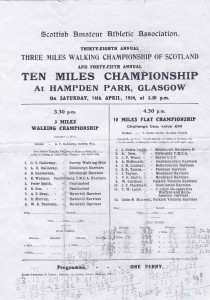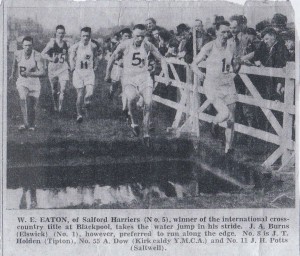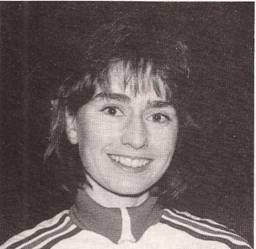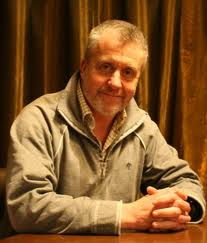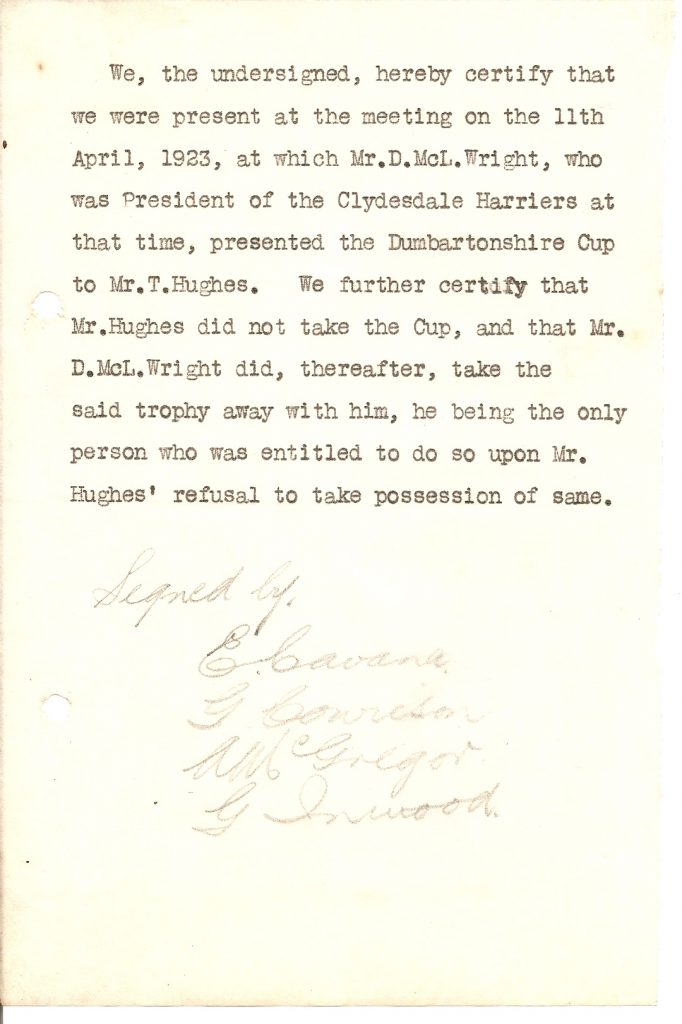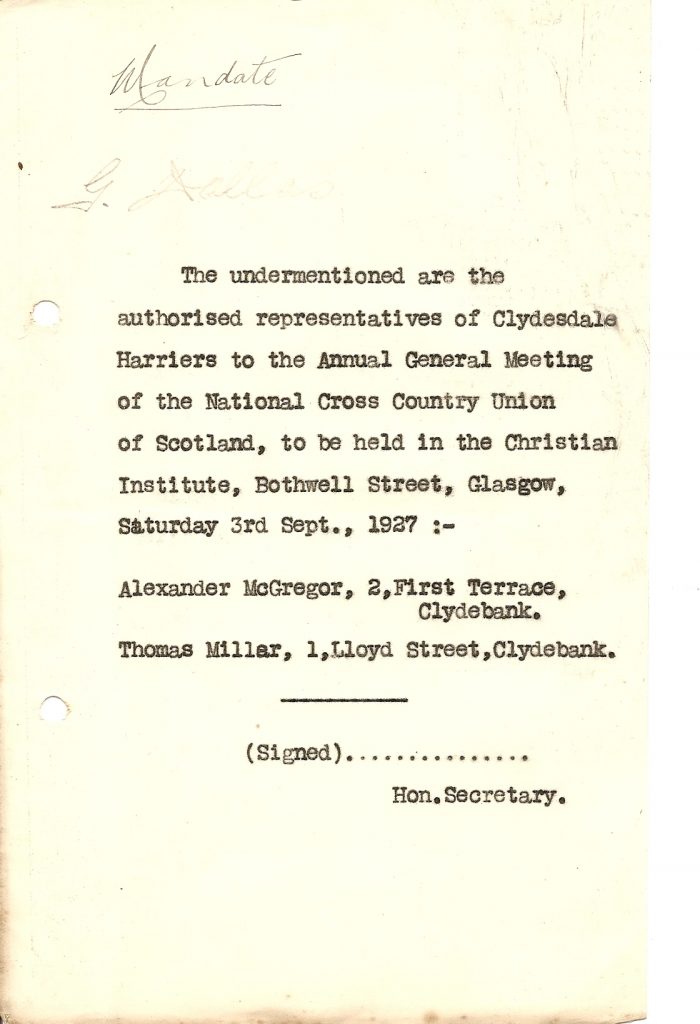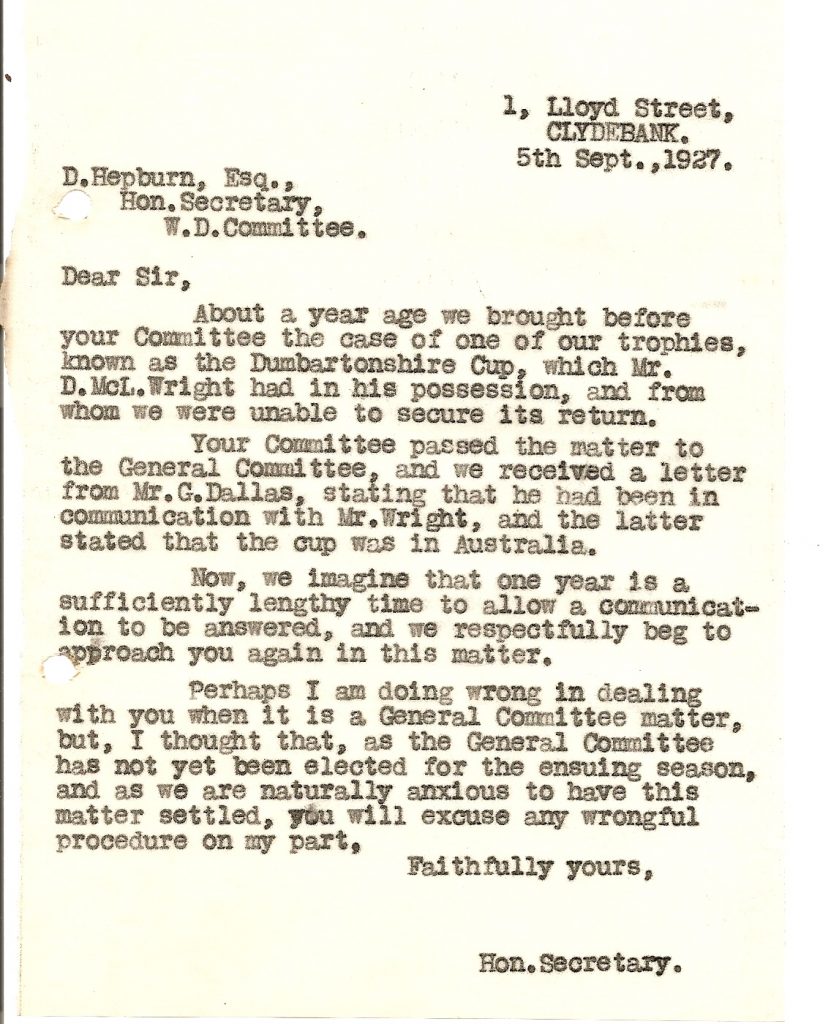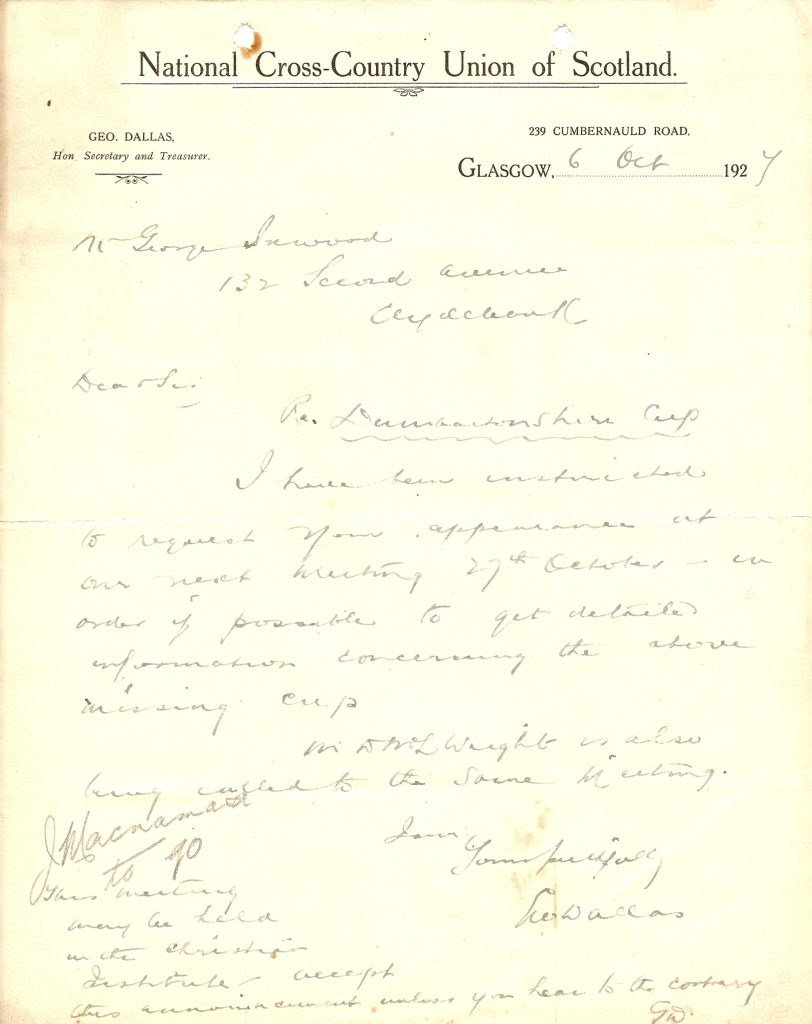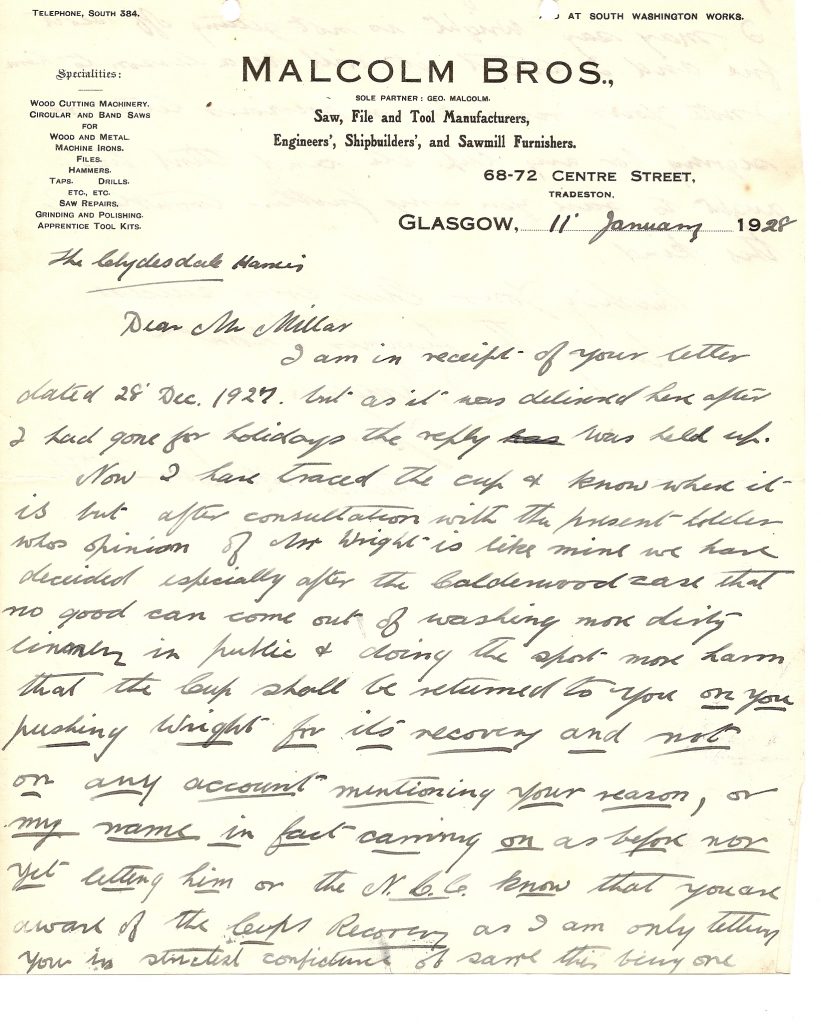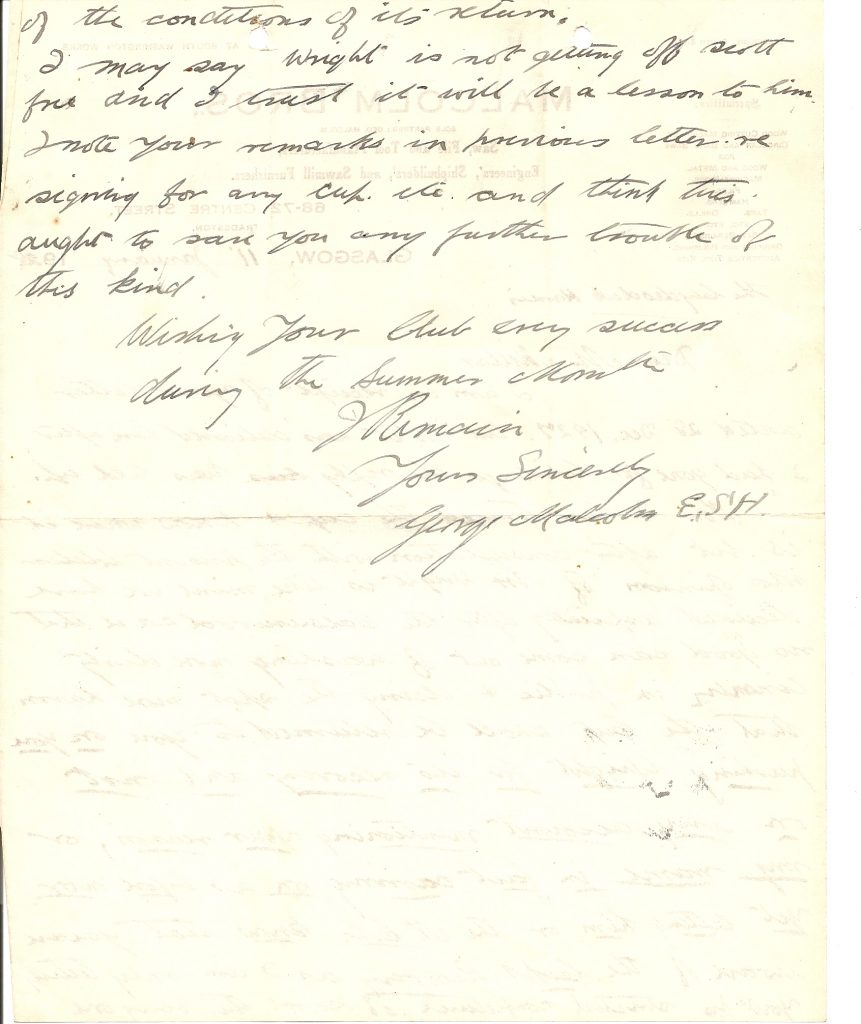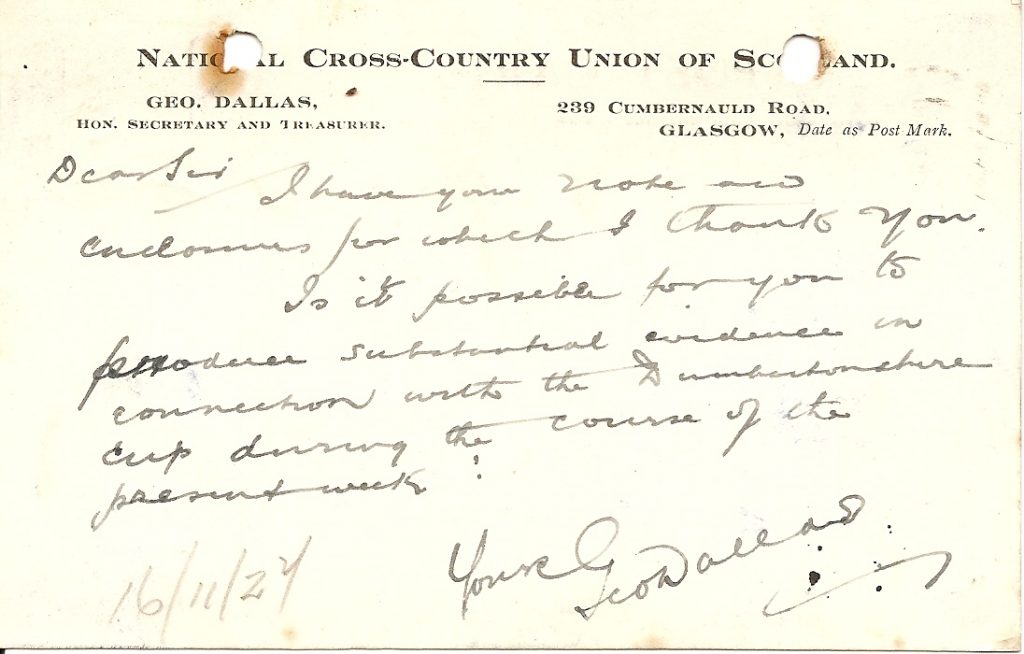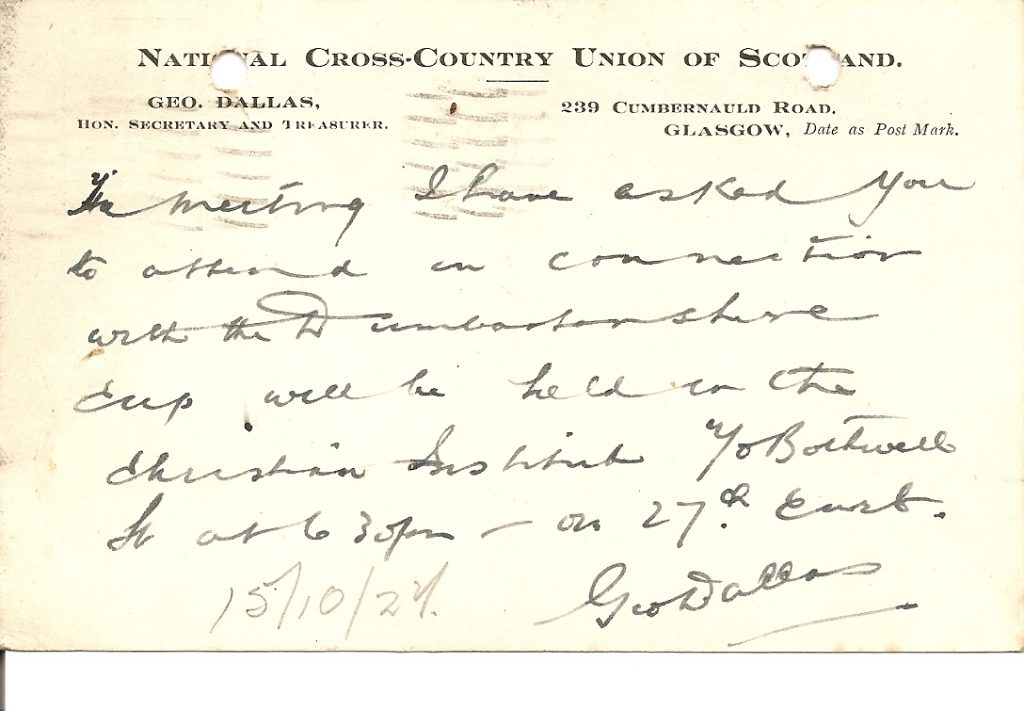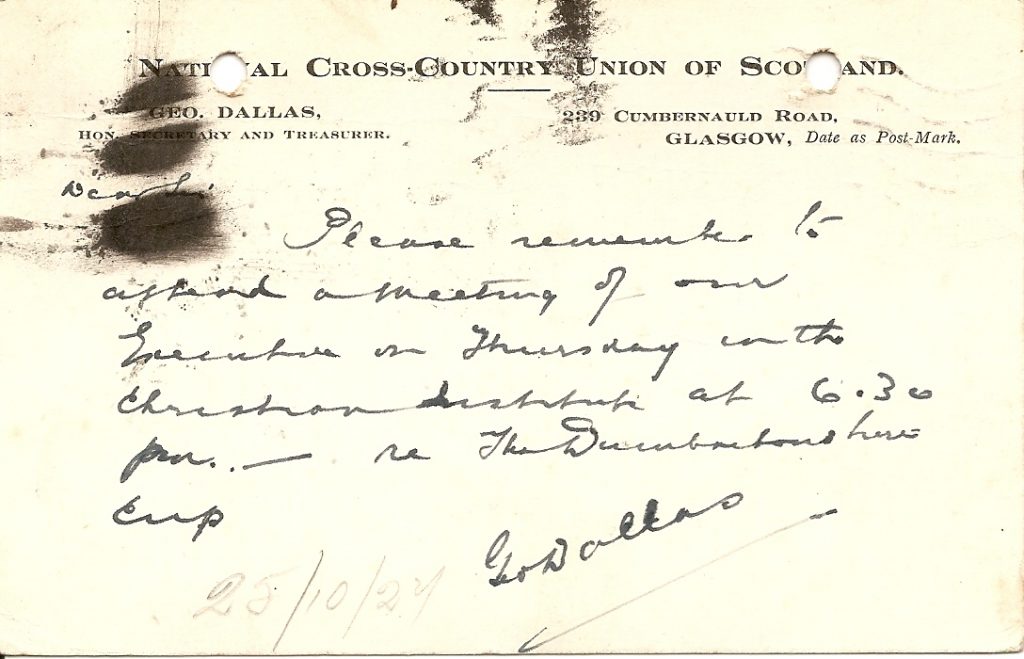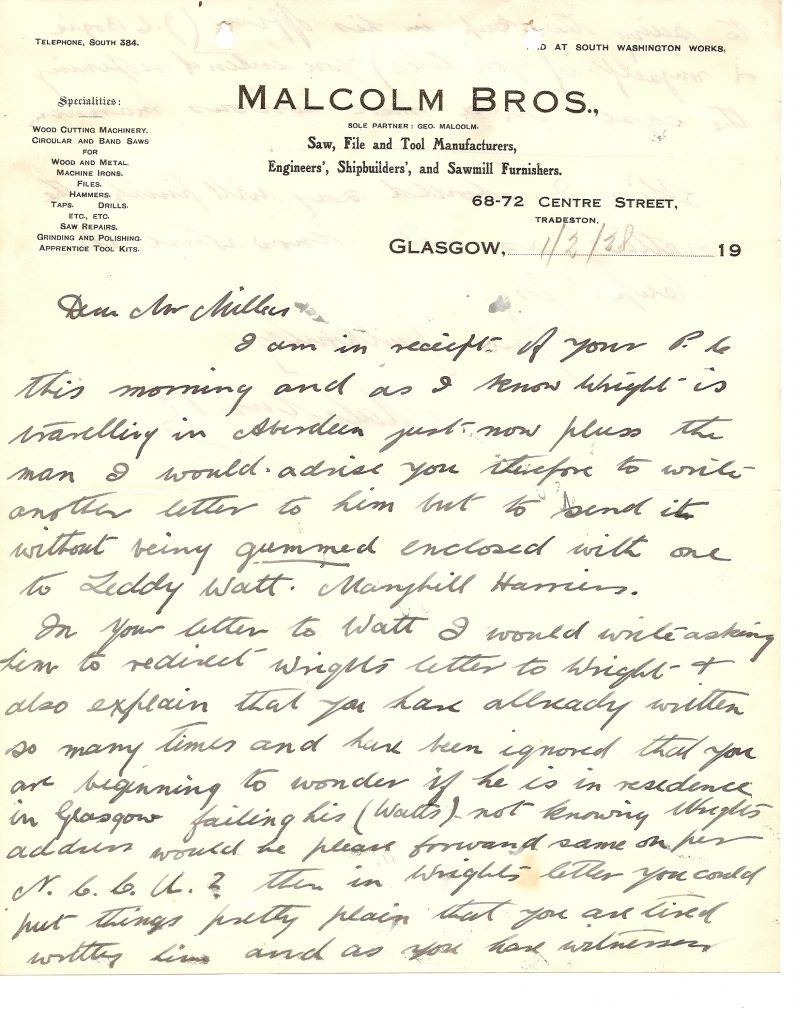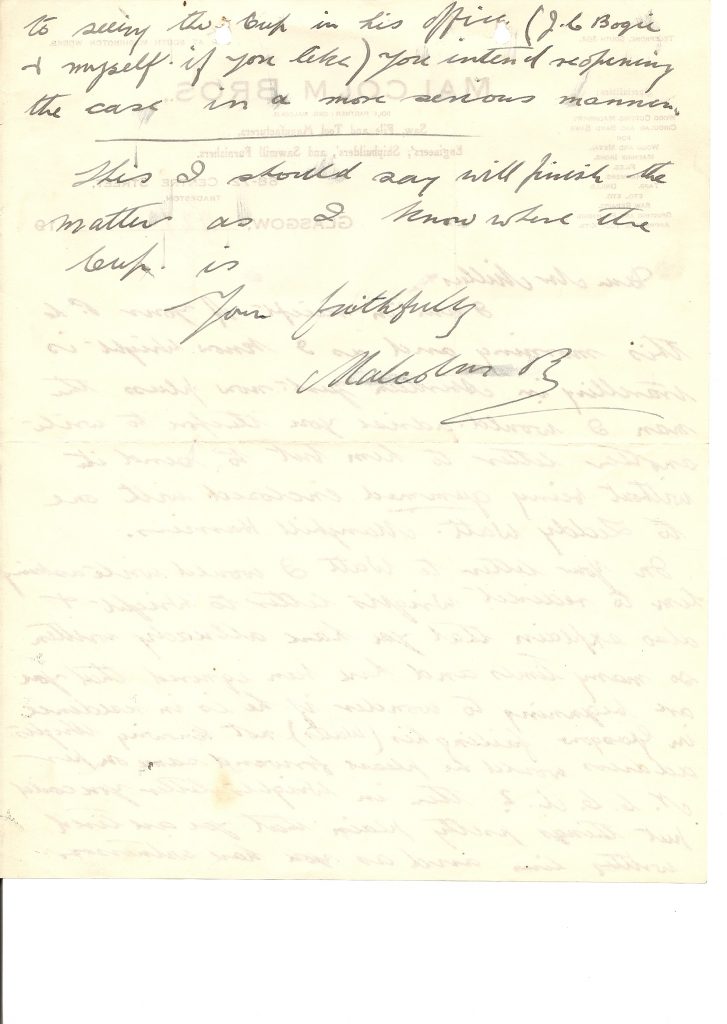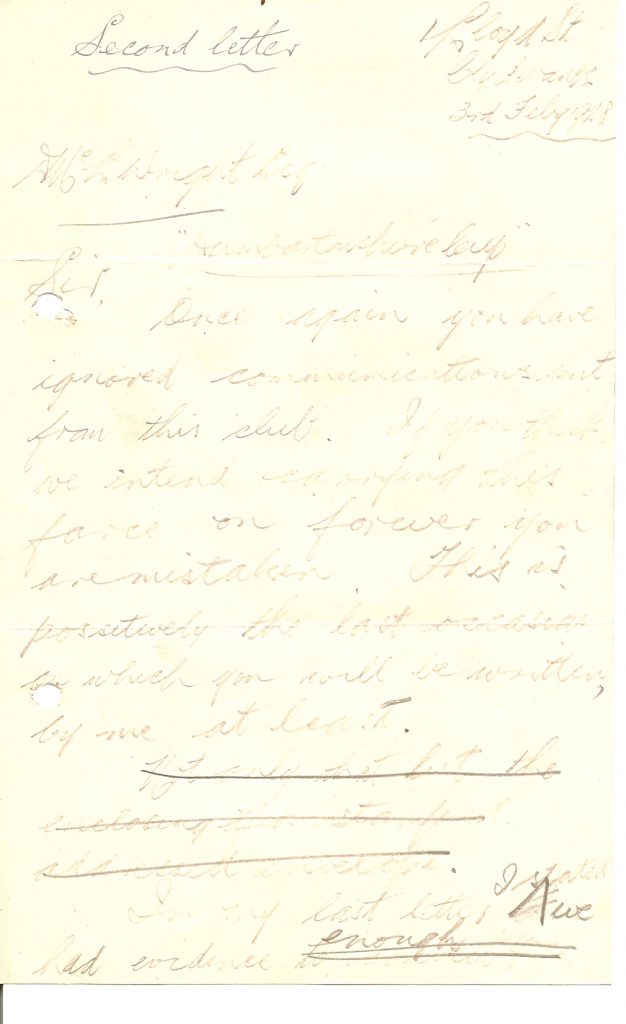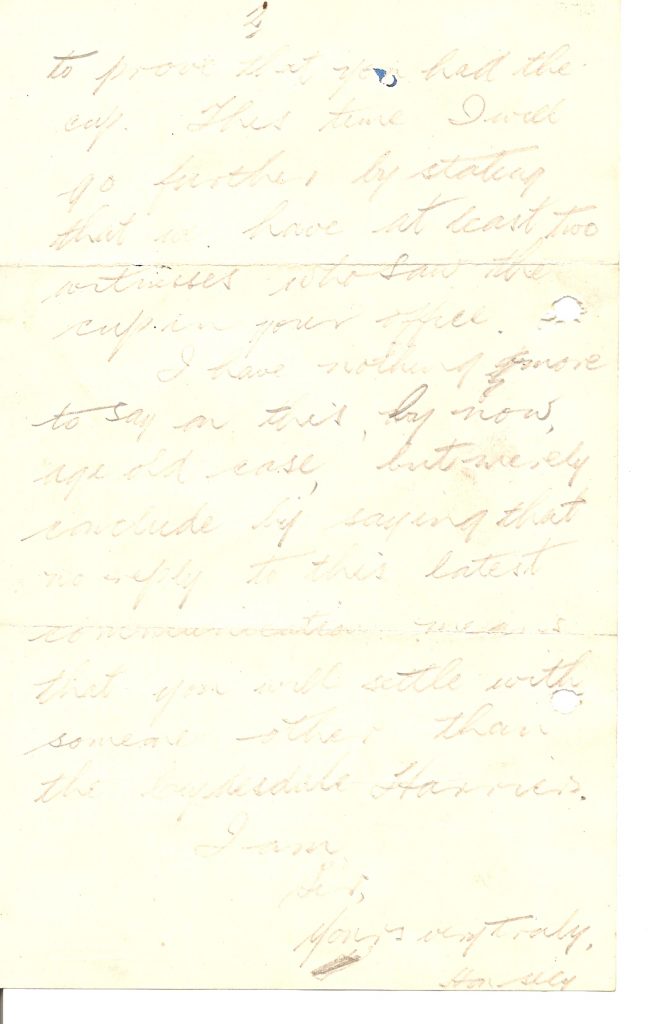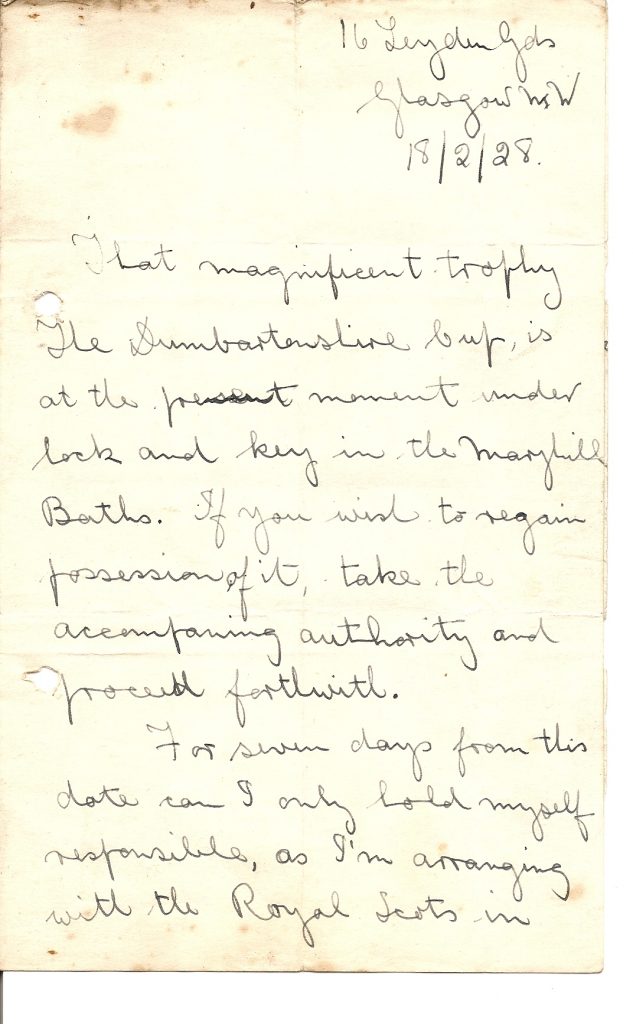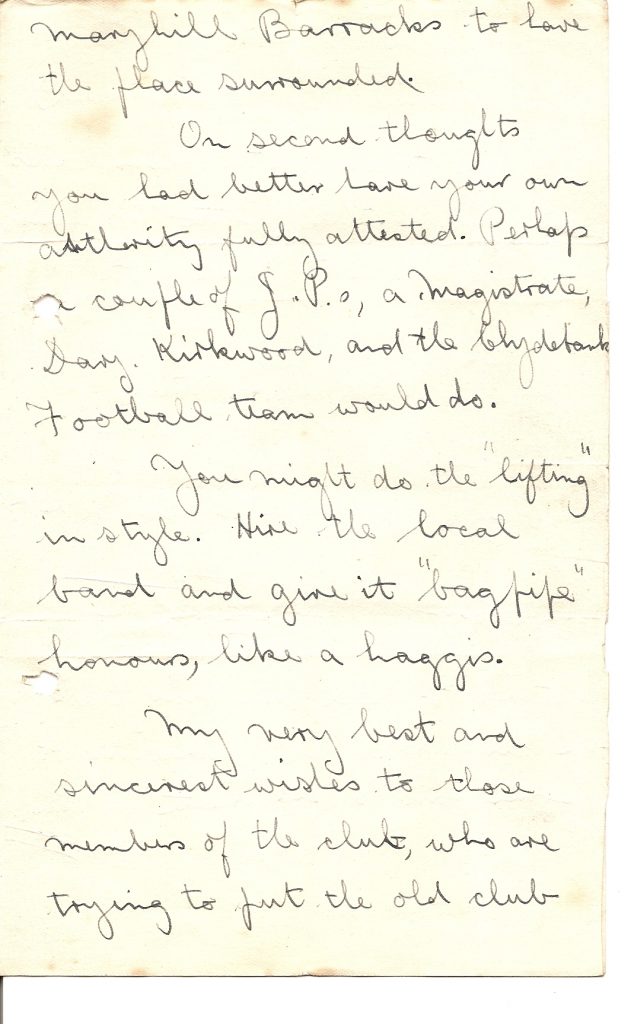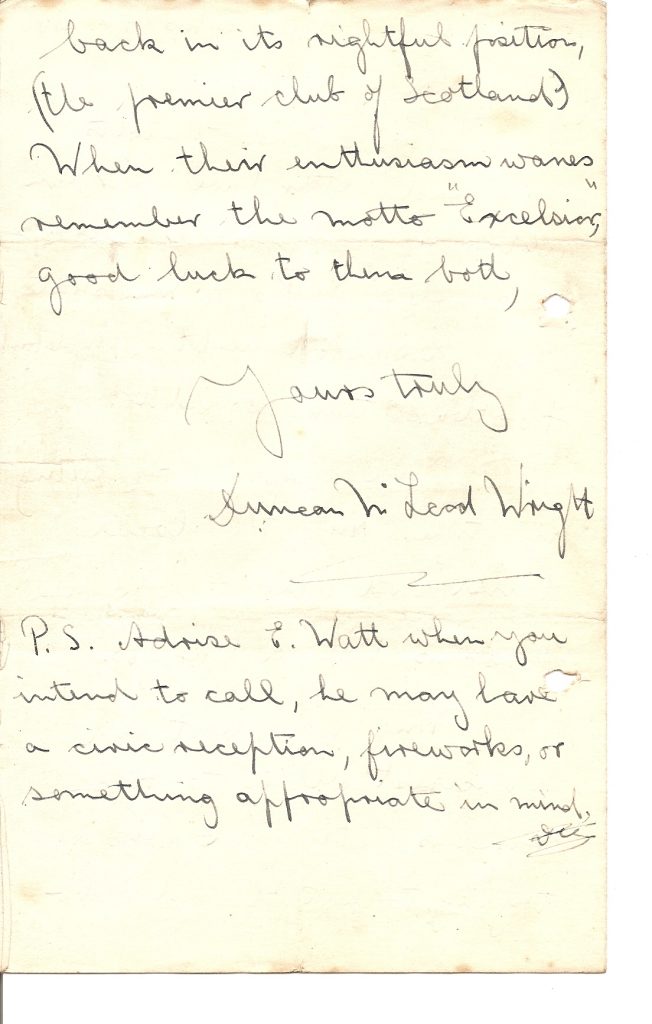[Not a valid template]
Category: Uncategorized
Jackie Laidlaw’s Racing
| 1930 | 24 Jun | Hawkhill | Mile | 4:44.2 | 1 |
| 1930 | 5 July | Easter Road | Mile hcp | 4:27.2 off 100 yds | 1 |
| 1931 | 23 June | Hawkhill | Mile | 4:30.0 | 1 |
| 1931 | 23 June | Hawkhill | Half mile (Sco v Ire) | 2:02.4 | 1 |
| 1931 | 6 June | Hawick | Mile hcp | 4:33.0 off 60 yds | 1 |
| 1931 | 22 May | Inverleith | Mile hcp | 4:25.0 off 75 yds | 1 |
| 1931 | 27 June | Hampden | Mile (Sco champs.) | 4:35. | 2 |
| 1931 | 26 June | Hampden | Half mile (Sco champs.) | 2:03.8 | 1 heat |
| 1932 | 16 July | Powderhall | Half mile (Sco v Ire) | 2:02.9 | 2 |
| 1932 | 11 June | Hawick | Half mile hcp | 1:59.6 off 16 yds | 1 |
| 1932 | 24 June | Hampden | Half mile | 2:01.0 | 2 heat |
| 1932 | 25 June | Hampden | Half mile (Sco champs.) | 1:59.0 | 2 |
| 1932 | 25 June | Hampden | Mile (Sco champs.) | 4:29. | 2 |
| 1932 | 8 Jun | Hawkhill | Half mile | 2:05.2 | 1 |
| 1932 | 8 Jun | Hawkhill | Mile | 4:38.0 | 1 |
| 1932 | 4 July | Inverleith | Mile | 4:52.2 | 2 |
| 1932 | 7 May | Inverleith | Mile hcp | 4:22.8 off 30 yards | 2 |
| 1932 | 30 July | Powderhall | 2 miles | 9:59.6 | 1 |
| 1933 | 16 June | Meadows (Edinburgh) | Mile | 4:28.2 | 1 |
| 1933 | 16 June | Meadows (Edinburgh) | Half mile | 2:07.0 | 1 |
| 1933 | 27 May | Hampden | 1000y hcp | 2:16.8 full distance | 1 |
| 1933 | 14 May | Inverleith | Mile hcp | 4:20.0 off 20 yds | 1 |
| 1933 | 13 July | Craiglockhart | Mile | 4:28.0 | 1 |
| 1933 | 14 June | Hawkhill | Mile | 4:25.8 | 1 |
| 1933 | 22 May | Hampden | Half mile hcp | 1:58.4 off 8 yds (heavy track) | 1 |
| 1933 | 24 June | Hampden | Mile (Sco champs.) | 4:20.6 | 2 |
| 1933 | 8 July | Powderhall | 2 miles team race | 1 | |
| 1934 | 3 July | Helenvale Park | 2 miles team race | 9:29.0 | 1 |
| 1934 | 21 May | Ibrox | 3 miles hcp | 14:46.4 off 40 yds | 1 |
| 1934 | 13 May | Inverleith | Mile hcp | 4:24.5 off 10 yds | 2 |
| 1934 | 4 July | Craiglockhart | Mile | 4:25.8 | 1 |
| 1934 | 16 June | Penicuik | Mile | 4:36.8 | 1 |
| 1934 | 12 June | Hawkhill | Mile | 4:27.8 | 1 |
| 1934 | 19 June | Hawkhill | Mile | 4:32.6 | 1 |
| 1934 | 4 August | London | 3 miles (Empire Games) | 14:50. | 7 |
| 1934 | 5 August? | London | Mile (Empire Games) | unplaced in h2 | |
| 1934 | 26 May | Hampden | Half mile opening leg in relay | 1:59.0 | 1 |
| 1934 | 23 June | Hampden | Mile (Sco champs.) | 4:27. | 2 |
| 1935 | 5 August | Glasgow | Mile hcp | 4:20.4 off 20 yds | 1 |
| 1935 | 29 June | Hampden | 3 miles | 14:44.8 | 3 |
| 1935 | 22 June | Hampden | 3 miles (Sco champs.) | 14:46.4 | 1 |
| 1935 | 1 June | Hampden | 3 miles team race | 14:59.4 | 1 |
| 1935 | 20 August | Helenvale Park | 1 ½ miles hcp | 6:46. off 25 yds | 3 |
| 1935 | 20 May | Ibrox | 3 miles hcp | 14:31.0 off 75 yds | 1 |
| 1935 | 4 June | Meadowbank | Mile | 4:31.6 | 1 |
| 1935 | 27 July | Shawfield | 2 miles hcp | 9:16.2 off 45 yds | 1 |
| 1935 | 22 July | Berwick | 2 miles | 1 | |
| 1937 | 10 July | Carntyne AAC sports , Shettleston | 2 miles | 9:38.0 | 1 |
| 1937 | 12 June | Powderhall | Mile hcp | 4:27.0 off 25 yds | 2 |
| 1937 | 8 June | Hawkhill | Mile | 4:30.2 | 1 |
| 1937 | 22 June | New Myreside | Mile | 4:29.5 | 1 |
| 1937 | 8 July | Craiglockhart | 3 miles | 14:37.5 | 1 |
| 1937 | 30 June | Craiglockhart | 3 miles | 14:51.4 | 1 |
| 1937 | 15 June | Goldenacre | 3 miles | 14:57.5 | 1 |
| 1937 | 5 June | Hampden | 3 miles | 14:59.2 | 1 |
| 1937 | 8 June | Penicuik | Mile | 4:40.2 | 1 |
| 1937 | 17 Aug | Helenvale Park | 2 miles | 9:21.5 | 2 |
| 1938 | 30 July | Shawfield | Mile hcp | 4:21.0 off 14 yds | 1 |
| 1938 | 31 May | Hampden | 3 miles | 15:00.8 | 1 |
| 1938 | 14 June | Craiglockhart | 3 miles | 14:41.2 | 1 |
| 1938 | 25 June | Hampden | 3 miles (Sco champs.) | 15:06.0 | 2 |
| 1938 | 7 June | Goldenacre | 3 miles | 15:06.6 | 1 |
| 1938 | 9 July | Dundee | Mile hcp | 4:20.6 off 90 yds | 1 |
| 1939 | 20 June | New Myreside | Mile | 4:39.2 | 1 |
| 1939 | 28 Jun | Helenvale Park | 1 ½ miles | 6:58.0 | 3 |
| 1939 | 8 June | New Meadowbank | Mile | 4:36.6 | 1 |
| 1939 | 13 June | New Meadowbank | Mile | 4:35.4 | 1 |
Laidlaw was badly injured at a meeting at Firhill Park on 18th May 1936 and missed the track season.
1934 Empire Games 2 miles, The Scotsman:
„Scottish hopes in the 3 miles were raised by the excellent running of J.P. Laidlaw for about the first two miles. He was lying third at that stage, but the uneven pace and the hard track told heavily against him in the closing stages, and he fell behind to seventh place. His time was approximately 14 minutes 50 seconds.“
Many thanks to Alex Wilson for the photograph and the work done compiling this list.
Athletics in Yugoslavia
There have been several references to Hugh’s stay in Belgrade but he himself wrote an article for a VPAAC magazine in June 1972. Colin Young, the editor of the magazine, sent me a copy and I reprint it here.
ATHLETICS IN YUGOSLAVIA
During a stay of nine months in Belgrade, Yugoslavia, 1969-70, I indulged in some athletics with the Red Star club. Members will have heard of this club in connection with European Football, but as in so many continental countries, the club is multi-sport with sections catering for football, swimming, basketball, athletics, etc.
When I was there, Red Star (Crvena Zvezda in Serbo-Croat) had a large incomplete stadium accommodating 100,000 spectators, one reserve football pitch, one blaes training area, and a ramshackle, pre-fabricated changing hut of immediate post-war vintage. The athletics stripping room and its lukewarm spray were shared by the men and the women but not simultaneously. Immediately after I left Yugoslovakia everything changed. A tartan track was laid(one of seven put down by a German firm in July-August 1970) and I imagine the changing facilities were transferred to a more suitable site in the main stadium. So much for my luck.
The athletics section of the club was immensely strong with many high quality athletes including several national record-holders. In 1970 they were the Yugoslav Club Champions, and they would certainly win the British League Championship. If you look at the following list of best performers competing for them in 1970, you will understand why.
10.3, 20.9, 49.0, 1:51.0, 3:46.0, 13:35.0, 27:58.0, 8:52.0, 14.9, 51.8, 7’0″, 13′, 26′, 50′, 62′, 170′, 180′, 235′ and they could put out two sprint relay teams clocking 42.3. With 56.4, I was the fourth fastest in the club in the 400m Hurdles.
Despite the impression given by my description of their dismal changing rooms, Red Star seemed to have plenty of money, enough to lay a tartan athletics track, pay for full time coaches, kit out their members, run training camps in distant localities and also to subsidise the diets of the “heavies” (to augment the usual Yugoslav diet of beans, yoghurt and sour cabbage) and to distribute direct “grants” to their very best athletes.
Dane Korica, who competed against David Bedford at last year’s British Games and later came fourth in both the 5000m and 10000m in Helsinki, received about £20 per month from the club – the same amount as he earned in his job as a motor mechanic. This is quite normal and the Yugoslavs were amazed, almosty disbelieving, when I informed them that the likes of Olympic champion David Hemery got no “grants”. Was their disbelief justified, I would note that I was accused of lying when I told them that in Scotland we had tp pay for our own kit, club membership, travelling expenses and 7/6 per event to enter our own championships.
I trained in the stable of “Chika (uncle) Atsa”, a small refined gentleman who was coach to the national team in throwing events. I found myself among a small group consisting of some first class sprinters (10.5 men) , another 400m hurdler with whom I had great verbal battles, all in good fun, and an assortment of aspiring middle-distance runners, distance runners turned hammer throwers, sprinters turned javelin throwers, and some rather promising girls.
There was a measure of rivalry between the various coaches and their charges.
As to the aspiring athletes mentioned above, I grieved for them, as they trained all winter with us in the nearby parks and in the national Army stadium, venue of the 1962 European Championships, and got no cmpetition when the summer came around. Only the very best athletes are adequately catered for in Yugoslavia. There are no inter-club matches where the less gifted can get a run out. The season for me was as follows:
6th & 13th May – Belgrade clubs meting; 26th & 27th May – Republic of Serbia Clubs Championships (best twelve in the republic in previous local meetings to compete); 30th & 31st June – Yugoslav Clubs Championships(best twelve from republic championship to compete). There were also, after I left, another Yugoslav championship (slightly different from above) and an individual championship. Add to these an international meeting in Belgrade , from which I had to withdraw because of illness, and you will see that the average competent athlete (stop flattering yourself boy!) can expect a total of six races a year. So despite the amount of money poured into the sport. domestic competition is in a poor state.
Victoria Park club members may take heart from the fact that athletics in Yugoslavia where some deal of money is available, is in a worse-off state than athletics in Scotland about whose shortcomings I could preach at length. But I’ll keep the preaching to another article and hope in the meantime that the vagaries of Red Star, Belgrade, have provided interest and amusement.
Hugh wrote that in 1972 and it is of real interest to note that in 1969 the athletes in Yugoslavia were being paid – it is even more eye-opening to see how little competition was available to the athletes.
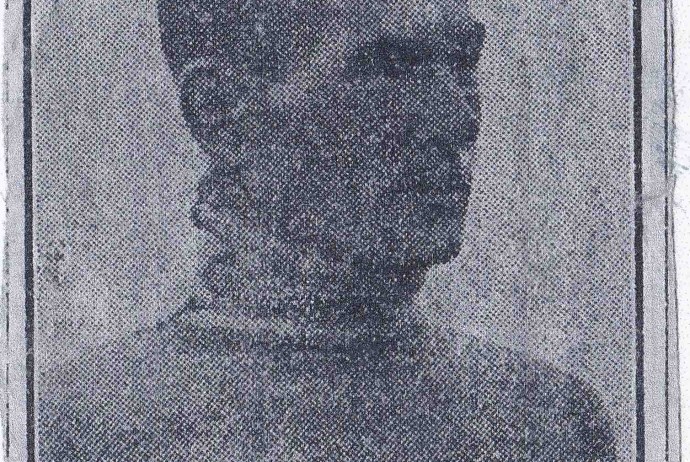
Alex Dow
Alex Dow should be better known than he is. He ran for Kirkcaldy YMCA in the 1930’s, won the SAAA 10 miles track race, ran for Scotland in five international championships and was always in the first three counters at a time when the Scottish team won more medals than in any other decade. The fact that his club was never ever right up there in the rankings or championships of course might have contributed to the ignorance of his career – nowadays he might well be recruited one way or another to a more fashionable club, but in his day good runners ran for their own clubs and were happy to do so. A native of Collessie, he lived in Dysart and died comparatively recently – in 1999 at the age of 92.
A local paper remarks on his start in the sport: “He had rather an amusing baptism in the sport. While with the Black Watch at Perth, he was sent out with a squad to the North Inch and told to run a mile. He won. After that, Dow won several races in the Army. After his discharge from the Army, Dow joined Kirkcaldy YMCA and speedily made his mark.”
He ran cross-country running in the winter of 1933/34 where he did well enough to win the Eastern District title and also took the Scottish Junior title. Colin Shields in “Whatever the Weather” comments that “Alex Dow (Kirkcaldy YMCA) ran away from his rivals to win the Eastern District title by almost a minute at Musselburgh racecourse, the first of many successes that included an ICCU international bronze medal just two years later.” Of the National he commented that he ran well to finish fifth and win the National Junior title. The international that year was held on home soil – at Ayr – and there were hopes for a Scots victory but according to Shields, they were simply ‘run off their feet ‘ after a fast start. Dow in 12th place was the third Scot to finish behind Flockhart (6th) and Sutherland (11th) to gain a bronze team medal.
He really sprung into prominence, however, on 14th April 1934 when he won the SAAA 10 Miles Track title. The “Glasgow Herald” reported on the race as follows: “J Suttie Smith, the champion was indisposed and did not defend his honour. A Dow, Kirkcaldy YMCA Harriers, the Scottish Junior and Eastern District Cross Country Champion, gave further evidence of his capabilities by winning rather easily. The champion was the only absentee of the 12 entrants for the 10 Mile Race. Once the runners settled down, it was seen that JC Flockhart, the Scottish Cross-Country Champion, A Dow, SK Tombe and JF Wood had the title in their keeping. They ran in the above order for seven and a half miles, at which point Dow went to the front for the first time. Flockhart and Tombe were close up at this stage but Wood had dropped back and seemed out of the running. Once in the lead Dow drew steadily away. Running strongly and in effortless style, the Kirkcaldy man went on to win his first SAAA title by some 200 metres. Tombe also finished strongly to beat Flockhart by 50 yards. The intermediate times were:-
One Mile 5 min 11 2-5th sec; Two Miles 10 27 3-5th; Three Miles 15 min 46 2-5th sec; Four Miles 21 min 07 sec; Five Miles 26 min 27 1-5th sec; Six Miles 31 min 32 2-5th sec; Seven Miles 37 min 13 1-5th sec; Eight Miles 42 min 36 sec; Nine Miles 47 min 51 4-5th sec.
1. A Dow 53:12; 2. SK Tombe 53 min 40 2-5th sec; 3. JC Flockhart 53:49.
Alex Wilson, who gave me a lot of the information for the profile (and who in turn owes a debt of gratitude to Don Macgregor, who is not only a great runner but an athletics historian), has been good enough to send me a copy of Dow’s own extract from the race programme with splits taken on the day by one of his entourage.
As Alex says, with splits of 26:27 and 26:54 he wasn’t a bad judge of pace. When it is borne in mind that his club did not have access to proper track for training, it is remarkable that the pace should be so even – the YMCA trained in the Beveridge Park, on grass, meetings were evidently held in Stark’s Park too in those days, but the harriers obviously didn’t have access to a cinder track.
In the following cross-country season, 1934-35, he won the Scottish YMCA championship, and then Dow was seventh in the National behind Wylie (Darlington), Flockhart, Suttie Smith, Freeland, C Smith and William Sutherland. Excellent company to be in. In the International on 23rd March in Paris, he was second Scot to finish when he crossed the finishing line in tenth place with only Wylie (second overall) ahead of him. Flockhart, Suttie Smith and the rest were behind him: the “Glasgow Herald” simply said “Alex Dow (Kirkcaldy YMCA and 10-mile champion) again rose to the occasion, gaining ground steadily to finish tenth.” The local paper described it as a “Splendid, judicious race.”
Into summer 1935 and Alex was again competing in the SAAA 10 Miles track championship: this time he finished third behind Willie Sutherland and Jimmy Flockhart. He gained another medal in the National Championship at the end of the cross-country season when, according to Shields, he was as far back as thirteenth at one point but came through to be third at the finish. About the International in Blackpool, we read , “Alex Dow in all his five Scottish international appearances in the 1930’s, was never outside the first three scorers for the Scottish team, displaying a natural ability that gained him many victories without any great training schedule or hard work behind him. In the 1936 international Dow was at his best over flat fast course with scattered artificial obstacles. He was part of a team that included three men – J Suttie Smith, RR Sutherland and WC Wylie – who had all finished runner-up in recent years, but the main Scottish hope lay with James C Flockhart who was undefeated all season. The race was run in blazing hot sunshine and Dow, accustomed toi the torrid heat from his Army service in the Far East, was more at home with the weather than his colleagues. Starting in tenth position after the opening rush, he was eighth at half distance, sixth at 6 miles, and a relentless surging finish brought him home third, just six seconds behind Jack Holden, a three times winner, with British 6 and 10 miles record holder William Eaton finishing a clear winner by a 150 yard margin.”
1936 International Cross-Country Championship: Dow is Number 55
A local paper at this time described his training: “Dow trains on Tuesdays and Thursdays over the road varying his distances from three to five miles, and covers seven miles over the country on a Saturday. Dow does not bother himself unduly about diet, and ha so far failed to set for himself any special course of training for big events – more proof of his natural ability. No present day runner covers the ground with less effort. If one carefully watches his striding methods, it will be observed that his leg lift is of the minimum height, reminiscent of the style of the great Arthur Newton of South Africa who holds many long distance road records.”
If his selection for international duty so far had been eminently clear cut, this was not the case for 1937. He finished 102nd in the National at Redford Barracks in Edinburgh and was selected to run for Scotland. It had been the case that the first six were automatically selected and I don’t know of any runner finishing outside the first 100 to be picked for the International. Alex Wilson has looked into this carefully and has this to say: I have found some interesting stuff on Alex Dow’s selection for the 1937 ICCU Championship. It seems that it was the subject of heated debate. Many felt that the running order in the national championships should be the sole criterion for selection rather than the, in part, discretionary selection method favoured by the SCCU. According to Athlon (an athletics journalist) ‘This year the Scottish officials accepted the first three men – Flockhart, Farrell and Sutherland – without discussion, but all the others were put to the vote.’
One item (source unknown) re the Scottish Cross-Country Championships states: ‘The most remarkable failure was that of Alex Dow of Kirkcaldy YMCA. During the season Dow has hardly shown the form expected of him, but few looked to see him fail to finish inside the first 100. The Union, by including him in the team for Brussels, have shown they keep their confidence in him, and certainly his distinguished service in the past gives a guarantee that his form on Saturday was a temporary lapse. Dow may make a good recovery at Brussels.’
Another item states: ‘One of the most distracting features of the Redford race was the running of Alex Dow, Kirkcaldy, who finished only 102nd. His loss of form seems inexplicable, but bearing in mind his brilliant running for Scotland in previous races, the selection committee has given him a place in the team again.’
Athlon wrote re the ICCU selections: ‘I do not think the team is open to much criticism. the selectors have evidently chosen A Dow on the strength of his last season’s running, when he finished third in both Scottish and International championships. I believe the Dysart man has been troubled by a leg injury, obviously he was not fit on Saturday, for more than a hundred competitors beat him. I am not finding fault with the Union selectors in finding a place for Dow, but I think they are being rather inconsistent. Only a couple of years ago they left out RR Sutherland because he only finished 26th in the national event. Last year however, they chose WC Wylie after he had run 44th in Lanark, and he did not let them down in Blackpool’.
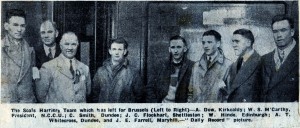 The 1937 International team – Dow on the extreme left
The 1937 International team – Dow on the extreme left
So how did he do in the international after so much ink had been spilt over his selection? Second Scot across the line, in 17th position, beating RR Sutherland by three places! The story of the day however was not his return to top form but rather team mate Jim Flockhart’s victory. Read about it here. The “Glasgow Herald” after devoting almost all of the report to Jim Flockhart had a paragraph that said: “Alex Dow fully justified the confidence of the Scottish selection committee. In finishing 17th he was second counting man for his country, beating RR Sutherland by three places. JE Farrell “stitched” badly at one point of the race but hung on grimly and eventually finished 23rd and fourth for Scotland.”
Alex Wilson’s comment is that “in the 1930’s at least the Scottish selectors had an uncannily good hand. These were clearly people with their ears close to the ground.” My own perspective is that at present selectors find many ways to avoid actually having to select a team – automatic qualifications, rigid trials, etc – and the thought of picking a runner who had been out of the first 100 in the national would be a boldness too far!
1937/38 was Dow’s last year and the 1938 international was his last. The national was to be held at Ayr in 1938 and 30 prominent runners were invited by Captain WH Dunlop to go for a training run over the course to familiarise themselves with it before the actual race. The race was on the same day as the English national so RR Sutherland missed it as did WC Wylie. John Emmet Farrell won the title by 150 yards from ‘a fresh looking Alex Dow‘ and PJ Allwell (Ardeer). The international was held at the Balmoral Showgrounds in Belfast where the Scots all ran poorly. Dow was 27th and third Scot. Some Press reports said that he had been second in the national despite not having trained hard and the Glasgow Herald report on the international, after lamenting the poor form of the Scots generally and the disappointing team performance had this to say of Dow: “A Dow found conditions against him and, in extenuation of his failure, it is remembered that he rarely does well except in fine weather and on firm ground. The race at Belfast was run in driving rain.” That is consistent with the reports of his run in 1936 where it was reported that the hot weather and blazing sunshine had suited him after his Army service in the Far East. He was however third Scot to finish.
He ran in other races – eg two weeks before the international he ran a fast time for his club in the Perth to Kirkcaldy Road Relay – but his international career was finished. If you look at any of the team photographs you will see that, along with RR Sutherland, he was the tallest in the team – probably over six feet – and it is no surprise to find out that he was a policeman. He took up a post in Palestine in 1939 his running career, as far as we know it, was at an end.
Like many of his generation, Dow was a very talented athlete who had a short career – the length of which was dictated by his occupation, it was terminated by his occupation too. If we look back at his ten miles triumph in 1934, the pace judgment was immaculate and in most of his races he tended to run steadily throughout and come through dramatically when others were tiring. This was done without the assistance of pace training on a track although it is possible that his road runs were what we would today call ‘tempo runs’! The country was blessed with many fine athletes in the 1930’s – possibly a golden generation?
Some Tributes …
John Anderson has had many athletes pass through his hands and they almost universally have good memories and entertaining tales to tell, Some of these tributes are set out here – appreciations of help given and friendships made and maintained. I await more which will be added once I have seen them. First of all there is Dave Hislop who has known John since the early 1970’s. Dave ran for Edinburgh AC and Birchfield Harrierss with pb’s of 53.08 for 400m Hurdles and 49.25 for 400m flat. He ran for Scotland no fewer than 10 times between 1978 and 2004. Details of his career can be found at
http://www.scotstats.com/sats/uploads/ARCHIVE%202013/Final%20Profile-Men%20G-L.pdf
He says:
John Anderson -A Few Words! Perhaps a contradiction of terms but here goes…
I have had the privilege of knowing John for some 40 years during which time he has fulfilled a number of role in respect of me and my family ranging from coach, friend, employer, mentor, confidant, advisor, godfather to our son to mention but a few. He is undoubtedly one of the few people I know who is capable of carrying out all of the above and more…
Without his influence there is no way I would have achieved what I achieved in my sporting career or my professional career. John is the type of person who gives people the skills to enhance their life it is then up to them to take these opportunities.
The sheer number of international athletes John has coached not to mention those who may not have attained international level but who reached heights that they would not have achieved without John’s guidance, speaks for his prowess as a coach.
I could write a book on the experiences, as could the hundreds if not thousands of others, I have shared with him over the years and still continue to do so but this is not the purpose of these words.
I would like to take this opportunity to publicly recognise the impact John Anderson has made on not only my life but the lives of my wife, Kay and son, Jordan. The world of athletics has certainly benefitted from his input to the Nth degree.
To finish then I would just like to say a massive thank you John for all you have done for me and my family and also from those who have been fortunate enough to have been part of John’s life.”
It’s a sound testimonial to John’s ability to inspire and educate in a way that is not narrowly focused on sporting success, but to go a wee bit further than that – or maybe a big bit further!
***
Second up is Lynne MacDougall whose career is documented at www.scottishdistancerunninghistory.co.uk in the section entitled The Milers.
“I first met John in Portugal at an International Athletes’ Club training camp in the spring of 1983. John had organised a paarlauf session on the cross country course for the endurance athletes there. As usual he was very enthusiastic about the session and turned it into a bit of an event. He has a very loud voice and used it to effect to encourage all of the athletes to work hard! John certainly made an impression on me that day.
At that time my coach, Ronnie Kane had just died and I was looking around for a new coach. Jimmy Campbell got in touch with John and asked if he might take me on.
John lived in Coventry with his wife Dorothy and I used to travel down to stay with them so that I could train with his group, which at that time included Dave Moorcroft, Judy Livermore, Eugene Gilkes, John Graham and the Australian 1500m runner Pat Scammell. I have heard critics of John say he only worked with ‘stars’ who came to him fully formed, but that is nonsense as he worked with many people from when they were young and unknown and also with many club athletes who were never going to become international athletes. However, he expected all of his athletes to be committed to training and to take a professional approach to their athletics whatever their standard. He and Dorothy opened their house to athletes and it was always full of people dropping in for advice or staying over to train. Dorothy is a wonderful lady who went out of her way to look after all of the athletes and make them feel welcome. I was just 18 when I first met Dorothy and being looked after like this when I was away from home meant a lot to me.
With John’s guidance I began to get on track with my training after having lost my way a bit after Ronnie’s death. In my view, John’s training is based around principles of specificity and speed endurance. There is no periodisation in the strictest sense, but training in the winter and competition seasons are different as in the winter the emphasis is on training and in the summer on competition. Typical sessions included 4x600m with 5 mins recovery; 8x300m with 3 mins recovery; 150/300m x6 with the same distance jog recovery; 10x400m and 4x1000m for 5k runners. I also did 10mile runs and ‘stepping stones’: runs which are runs where you run 1mile at, say, 6min per mile followed by a mile at 6.30min per mile for 4 or 6 miles. I also did 20min fast runs.
With this training schedule and the support from the group I made a lot of progress over the winter of 1983. John’s encouragement was a significant factor in this. He was always very positive and encouraging of his athletes and has a great belief in them. My belief in myself did not always match John’s and I guess this was the one difficulty we had in our relationship. But I think that the training system works very well and I based my training around it when I was coaching for a short time with good results.
In 1984 I took around 10 seconds off my pb for 1500m and made the Olympic team. I remember the Olympic Trials in Gateshead well. It was the first time my parents and sister met John. My 18 year old sister did not have a ticket, but this was no problem for John. He liked to play a game with himself involving getting into every stadium he ever visited free. He put his arm round my sister and walked her into the stadium talking intently but every once in a while shouting out hello to passers by. As he expected no one checked whether they had tickets or accreditation because he looked like he was perfectly entitled to walk through the entrance. Alison got one of the best seats in the stand!
John was one of the British team’s coaches in LA, with specific responsibility for multi-events. As a 19 year old it was great to have my coach in the Olympic village with me. One day I went with John and two of the decathletes in the team for a stroll in Venice Beach. Venice attracts a weird and wonderful crowd of people and it was probably one of the few occasions I spent with John where he was one of the least flamboyant characters around!
Mostly, though John was the centre of attention! Gradually all of his athletes got used to this and it was just what they expected of John. I saw this quality being used to great effect though a number of times. One night we were at a charity event part of which involved an auction. The bidding was very sluggish and items were being sold for very small amounts. ‘Watch this’ John said to me getting up and taking over the mike from a timid announcer. In the next 20 mins John got the whole room so enthused that the bids tripled in value. The crowning moment was when he convinced someone to pay £250 for a photograph of two gladiators from the show he was working on at the time! This anecdote highlights some important aspects of John’s character and why he has had such an impact on many athletes and coaches lives: he sees opportunities when others might not, he does not think something is ever a lost cause, he is willing to pull out all of the stops to make things happen and he keeps on going until they do.
John is also fearless. He made much of his upbringing in the tough and mean streets of Glasgow (which was firmly tongue in cheek to those of us actually from Glasgow!) to develop a certain reputation. However I did see this toughness on one occasion when we were on a training camp in Spain. One of the girls in our group came running in and told us there were thieves in one of the athletes’ rooms. John was out of the door faster than Usain Bolt heading to the room which was in another building. He single handedly grabbed the two thieves and held them both against a wall until the police arrived! The police also took John down to the station to investigate this citizen’s arrest as the thieves complained about his treatment! However he was released a short time after and the athletes got all of their stuff back.
I continued to work with John all through the 1980s at the Commonwealth Games in Edinburgh and Auckland where he was an England Team coach. I stopped competing for a time in the early 1990s but then in 1995 I decided to start training again more seriously. I had a couple of people who helped me but eventually I got in touch with John again. He was living in Dunfermline and so I was able to see him again regularly. As I was older it was a different sort of relationship. It was more about chatting through ideas. It was great to have John and Dorothy’s support again and to know there were other people I could turn to when I had problems. John helped me train for the 5000m and I had a fairly successful season in 1997.
My track career did not end very well. I dropped out of the AAA’s 5000m and I felt that I was done with running. However, I started to run more on the roads and began to enjoy it again. Once again I went to speak to John about coaching. As I said earlier he does not give up on lost causes and suggested I train for the marathon! Despite having no background in distance running (I had never even done a half marathon) and my not exactly successful career to date he believed I could make the Olympic team!
Training for the marathon involved longer runs, but was still built a lot on ‘speedwork’. For example I did the ‘stepping stones’ sessions – but they were 9 miles long; a common session was 5miles fast/five steady/five fast; track sessions were about 10km in length; long runs were about 15miles to 20miles once a week.
In the end I ran 3 marathons. I did not get the Olympic qualifying time but was selected for the 2002 Commonwealth Games. However, I developed a back injury and could get no-one to treat it effectively. I felt I had lost too much training and gave up my place in the team. I think John was disappointed about this decision as he believed I could have competed. I retired soon after.
I will be ever grateful for the time John gave me and his support over the years. I am glad that through this profile a wider group of people will get to know about and develop a better appreciation of John’s contribution to athletics. ”
Hamish Telfer
Early in his career he coached Hamish Telfer and his friend Cameron McNeish. Cameron went on to become famous as a climber and hill-walker with many books and publications to his name and Hamish became a top class coach in his own right. If you want a review of his career go to
http://www.theleisurereview.co.uk/events/HamishTelfer2.pdf
Hamish sent some of his recollections of his time with John and they are presented below, just as he worded them.
“I understand John was born and brought up in Govanhill, Glasgow. He attended Queens Park Senior Secondary School which was then in Battlefield before its move to Toryglen. I think he may have a sister but I am uncertain. I also understand that he was a fairly competent all-rounder at sport while at school and represented Scottish Schoolboys playing alongside Ally MacLeod. I believe he played centre forward. He may also have played for amateur Scotland. He was also a reasonable gymnast.
He attended the Scottish School of Physical Education at Jordanhill College, Glasgow. I am uncertain as to how many schools he may have taught at, but I certainly remember him telling me he taught at a pretty tough east end school in Glasgow where, to instil some discipline into his charges, he started a gymnastic club which went on to do well at either the full Nationals or the School nationals (possibly winning something). It was at this time in his career that his ambitions coincided with track and field athletics and he got involved as you know with Maryhill Ladies (in all its various early forms). I recall him telling me that in order to realise the ambition of getting to the top of the pile in about 5 years he had a simple dictum. If a parent brought their kid to be coached, they had to do something for the club. John had worked out very early on that he couldn’t get to grips with coaching if he was also the club secy., treasurer, dogsbody etc . He seemed quite ruthless in this demand, as I remember him telling me that there were a number of times that parents took kids elsewhere and he had to watch undoubted talent prosper at other clubs when he would have wished they were with him and his team of coaches. It was around this time that he applied for and got the Scottish National Coach’s job. Maryhill went on to develop and prosper further under the fantastic Jimmy Campbell (as did my own coaching career). [NB: Jimmy had been brought into the sport by John when he was coaching his daughter Mary at Maryhill Ladies AC]
I can’t remember exactly when I first met John but I suspect it was about the time I was 15 (1965). I trained with Cameron McNeish and we were good friends. Cameron was a sprinter long jumper as was I, but he was much better and it was in Cameron that John took an interest. We were members of the now (sadly) defunct West of Scotland Harriers (who also had Ian Walker make it to a Scottish vest at 400 – now a folk singer) and he took over Cameron’s coaching form the coach at the club who was John Todd. In doing so, he also took on me. Much later in my life on one of the occasions when I asked John why he took on a ‘good’ but not really talented athlete, he responded by telling me that apart from the fact that he knew I was a committed athlete (more of that later), he knew that to split up the training partnership could be detrimental to both of us. Cameron and I thus joined John’s ‘National Squad’ at a very tender age. This being the case, I remember John sitting us both down and ‘telling it like it was’ with regards to conduct. If we even sniffed any alcohol (John was, and I think still is, an abstainer), we were out on our ears. Same applied to smoking. We even got lectured about manners and conduct to others, especially women as well as our appearance. We were left somewhat traumatised by the experience but left in no doubt who was boss. I think he did this as he recognised we were very young and he certainly didn’t want anything getting out of hand. Application and hard work also had to be applied to school too.
He was very strong in his views about egos. He encouraged us to believe in ourselves and to feel that there was nothing we couldn’t achieve with hard work and application but he had no truck for big heads (although he did coach David Jenkins which, given David’s ability to appear grandiose on numerous occasions, seemed slightly at odds). He had numerous ways in which he could deflate athletes who believed their own hype and I saw it in action on a number of occasions. I later found out, much to my embarrassment, that my mother, concerned that I was spending considerable amounts of time seemingly with a stranger, sought him out ( I have no idea how) and grilled him. He told me later in life that he could now see the funny side of it but at the time my mother who was a small, slight woman of only 4’10’’, really put him on the spot, especially with regards to training interfering with my school work.
As soon as we joined the squad our training patterns changed under John’s direction. He arranged for us to train with Maryhill Ladies mainly in the winter and I well remember the Friday night sessions at Westbourne School (Madge Carruthers was head of PE there). In addition there were the (mainly winter) sessions at the (newish) Grangemouth Stadium. He also encouraged us to train with the better women sprinters in his charge, and I spent some considerable time training with Avril Beattie and in effect acting as her training partner. She worked in a bank I think, but would get changed at work and meet me near the Queens Park and we would do rep sessions in the park at least once a week in the dark and having to climb over railings to get in and out again. Cameron and I also trained with Anne Wilson (a PE teacher) who was a Scottish International at sprints and LJ. Anne was terrific fun and was the instigator of mischief as well as all of us getting T-shirts bearing the legend ‘Nohj Squad’ (she always addressed John as Nhoj and got away with it). The squad took great pride in its identity and identification with John. Some of the other names I remember were Hugh Baillie, Bob Lawrie, Dunky Middleton, Stuart McCallum, both Jenkins brothers, Lindy Carruthers, Moira Kerr (with whom I did weight training twice weekly at Springburn Sports Centre). There were undoubtedly others but I am uncertain whether they were the core group or simply joined us: Fergus the steeplechaser from Edinburgh Uni, Dougie Edmondson, Lawrie Bryce, McPherson another thrower, Hugh Barrow, Ruth Watt, Adrian thingymabob who was a miler/1500, John Lyle etc etc. My memory needs jogging as to who was around at the time.
John held sessions at Springburn Sports Centre every Tuesday in the winter which was a combination of weights and conditioning. They were hard graft! I remember one occasion when John was called away to the phone at the start of the conditioning session and we wondered what to do as more than 10 mins had elapsed and he hadn’t returned. We decided to carry on (Dunky Middleton was one of the ones in the session so it was a mixture of senior and youth athletes). When John came back 50 mins later we were still going! Knackered but still going. Cameron and I would walk from our schools in the south side of Glasgow to get to these sessions as we only had enough money for a fare one way, so decided to get the bus for the homeward journey. We called in to my Gran’s flat in Springburn often after the session where she would feed us both with bacon and eggs.
John also used Cameron and myself as ‘athlete demonstrators’ on coaching courses both during the week and at weekends and have particular recollections of him picking me up and taking me to Ayr, Inverclyde and various places around Glasgow and Edinburgh. Quite exciting for a young, impressionable athlete. One of the reasons that he was able to do that was he had a firm belief in all-round conditioning for all his young athletes (not the case with the Seniors who he took on). All youngsters in his squad had to master all decathlon events and when the Scottish Schools Easter Athletics Course was under his control, part of the week was dedicated to two days of decathlon competition. This was part of his philosophy that although we start out in one event we may of course end up in another.
Other anecdotes stand out. Cameron and I used to sing in the showers at Grangemouth and this started something of duel between the women in the next changing room who could hear us and the rest of the male squad. It became a standard feature of sessions for a while as to which changing room could outdo the other and John would join in although not so good with the falsetto part in The Righteous Brothers ‘You’ve Lost that Lovin’ Feeling’.
Three other incidents stand out.
-
When Cameron and I were about 18 or so, we bought motorbikes to help us get around to training. This made it easier to get to John’s house too. We often went over to his place at Hamilton to help him splice films for his Specto analyser which he used on coaching courses. This allowed us unparalleled access to his knowledge and to quiz him and to see repeated footage of the likes of Eddy Ottoz going over hurdles. This was without question where I started to chart my career path, as I realised I had a thirst for this and indeed, something of an aptitude. John must have been a bit sick of never being able to get away from us but never complained and his then wife Christine (who was a lovely young woman) must have felt we were like contraceptives. In one particular incident however, I remember going to John’s to get picked up to go to Grangemouth early one Sunday morning. It was in the depths of one the coldest winter spells and it was well under zero in temperature and i was on my small 50cc motorbike. By the time I had got to John’s from south side Glasgow to Hamilton I was more than a bit cold. I got off the bike (just) and made it to his back door and then must have collapsed against the door with hypothermia. I remember nothing until coming round laid flat out in front of the fire in the front room with my head on Christine’s lap. While she was concerned, John wasn’t! He got me up as quick as he could, bundled me into his car (a Volvo after his little VW beetle) and with the heaters in his red Volvo going full blast, we made it to Grangemouth where his only concession was to ‘allow me’ to miss the morning track session substituting it for a 10 mile run (to warm me up again) and then into the afternoon track session.
-
John took Cameron and myself down to Cosford to run indoors when we were about 16 or 17. While I can remember one visit entailed staying at the student halls in Loughborough sleeping on the floor of the rooms of the likes of Mike McKean, Mike Varah and co., I also remember one trip undertaken in dense fog either on the way there or back. On the trip with the freezing fog ……. John asked Cammie and me to get all our clothes on; everything we could put on that we had. Perplexed we obeyed. He then put me in the back with Cammie and then he instructed us to open the windows (one of us on each side) and lean out a bit and give him instructions as to when he might either cross the white line or hit the verge so he could drive a bit faster. I remember these trips usually entailed us getting to John’s the night before to sleep over in order to get up at something like 3am to set off. My life with John always seemed to have theme of ‘cold’.
-
On which note – John was proud of a particularly vicious session he used to inflict on us called 20 second runs. Usually reserved for the Grangemouth sessions, it was indiscriminate in its(his) ability to reduce quality athletes to crawling about the track barfing up what was left in their stomachs. I remember Hugh Baillie being left prostrate on more than one occasion as was Bob Lawrie. The one that sticks in my mind was the session he sprung on us on Christmas Eve one year (which happened to fall on a Sunday, hence Grangemeouth). Thinking we would have one of his fun sessions of a continuous relay with all events involved for fun, he sprung the 20 second run session on us. It was also snowing very heavily. I still have memories of crawling on to the infield after ‘hitting my mark’ and seeing a pair of snow covered feet in front of me and hearing him bark ‘make or not?’ When I responded ‘only just’, he simply bawled, ‘go again’ and moved on to the next victim. We never saw him through the snow in that sheepskin trade mark jacket of his, but we heard him. We were wearing vests and shorts!
Cammie had left athletics by the time he was about 20 as by then he was in the Police Force and the shifts were difficult to fit in and he had also met his future wife and got married at 21. I got a bad injury at PE College and stopped competing in 1970 too. However without a doubt John, for all his faults (and he had many – temper, pig headedness, obstinate, argumentative) was a wonderful influence on me and I owe virtually everything in my career to John’s influence. Indeed it was interesting to hear some people remark that I was a mini version of John when I taught and coached. I would not have had the career I did without John’s help and encouragement.
Later on when I left PE teaching in Scotland in 1975 to take up the post of National Technical Officer (National Coach) for the Royal Life Saving Society, I was then the youngest full time National Coach in any sport in Great Britain. I have since been a GB team coach in Wild Water Canoeing (don’t ask) and also back in my own sport of athletics for cross country. At the top in 3 sports and much of it down to John and his grounding in confidence, learning, knowledge and hard work.
My final ‘memory’ was of the only time John paid me a real complement (this from a man who once described my start from the gun as ‘like watching milk turn’ in terms of ‘response’!) and in true Anderson fashion it came when it mattered; in front of my peers. I was heavily involved in the British Association of National Coaches in the middle part of my career and was one of the ones charged with considering moving the Association forward from its rather elite membership of past and present National Coaches to meet the demands of widening audience of coaches who needed a ‘Coaches Association’ to get their voices heard (we are still waiting!). We invited John as a speaker to our annual conference one year. At this point John and I had not been in contact for some time. We briefly chatted before his session before he went on to talk to the assembled National Coaches from all sports. The talk was about the ‘coach athlete relationship’ or something along those lines. There were just over 100 in the room.
He started his session by saying ‘There is someone in this room who epitomises what a hard working, committed athlete is. Without such athletes, coaches such as yourselves cannot achieve the highest levels of success since talent alone seldom, in my view, is enough without the ability to work hard. That person is Hamish Telfer.’ I can remember it almost verbatim and was quite overwhelmed as I knew it was not in his nature to say things like this. In typical John fashion he had his punch line however. He continued by saying (I suspect in order to lighten the moment) something like … ‘Without a doubt he was the hardest working athlete I have ever coached but unfortunately for Hamish he possessed not a grain of natural talent.’ I still felt quite chuffed but do remember when the laughter died down saying ‘and it’s taken you 20 years to tell me I was crap then Anderson?’
Despite the flaws he inspires fierce loyalty and when I talked to Cameron that is what he remembers too. “
***
Finally, Eric Simpson from Fife paid a wonderful tribute to John and I simply quote it in its entirety.
Dunky Wright Correspondence
The DM Wright/Dunbartonshire Cup Saga
When Dunky Wright resigned from Clydesdale Harriers in 1923 he took with him the Dunbartonshire Cup. There is a whole series of letters, claims, etc that are detailed to some extent in Colin Shields’s book “Whatever the Weather” but much more completely on the linked page on this website/
The correspondence here covers the ‘end game’ of the quest for the trophy with Dunky having the final say in a funny letter – part bitter, part humorous – bringing the sage (it lasted for four years +) to an end. It is however clear that he was not happy in being ‘found out’. Mr Millar, referred to in the letters and postcards is Tom Millar, club secretary.
…
/
